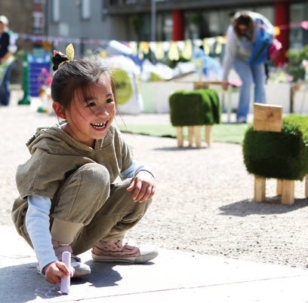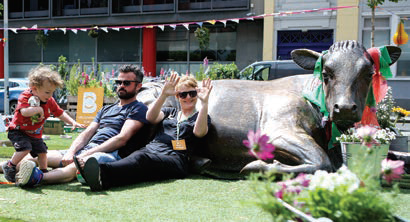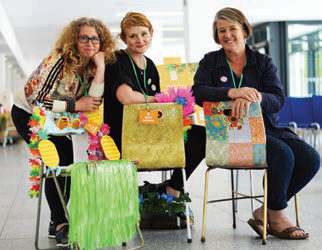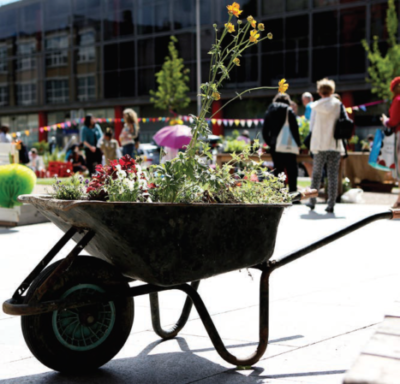In an exciting new series of collaborative articles, the team behind the hugely successful BloomFringe share their thoughts on how horticulture, art, and community can come together to bring sustainable and positive change to our lives
The BloomFringe focus has been across the city of Dublin, in public spaces, in community gardens, at ambiguous forgotten junctions and places we particularly love – what we term impoverished corners of our city. Our bi-line is ‘making the gritty city pretty’. BloomFringe hosts talks and tours and curates a series of temporary pop-up gardens and events. We link communities together and foster collaborative projects, which make long-term connections and help to change people’s perceptions and experience of the city.
BloomFringe is echoing a global urban greening zeitgeist. Inspirations like pocket parks in 1970s New York, Danish urban playgrounds of the 1960s, community gardens in Berlin and Havana, beehives on Paris rooftops, flower-filled verges and roundabouts in Sheffield, have for us formed a green map of nature across the world’s cities. As urban populations grow, humans are calmer and happier if they have a green space to retreat to, even if it’s only for a sandwich at lunchtime. It really is a case of putting the jungle back into the Urban Jungle.
Prompted by the plight of the honeybee and other serious global environmental concerns, the BloomFringe mission has evolved over the past four years forming our core principals
now of making cities more livable through greening projects that bring neighbourhoods, communities, and people together. We have connected too with others making similar changes in their own cities right across the world. They have spoken at our conferences, spreading the story of the effect urban greening projects have had internationally. It was very powerful for a community gardener in our north inner city to meet the Gangsta Gardener Ron Finley from LA last year and to make genuine friends and share stories,
seeds and growing tips together. Practitioners of the power of gardening to ease mental health issues were thrilled to meet Sara Venn of Edible Bristol this year to hear about how
her greening project in the Bear Pit drew out the anti-social behaviour that dominated their city centre public space for decades. In Dublin Castle this year Ulla Maria Aude’s
presentation of Aarhus city’s Green Embassy and Green Wedge projects gave Dublin’s decision-makers an excellent view of potential urban greening templates.
All of this BloomFringe energy coupled with a city council who is adopting forward-thinking planting schemes for our urban public spaces and more innovative use of the public realm makes for a dynamic combination. Other public and business support mechanisms enable the Festival and our other periphery events throughout the year. This all builds a great community between ourselves and the other stakeholders and supporters at the same time as facilitating us to make connections to people in our city through greening projects. It’s pretty cool stuff! We have ideas and inspirations coming out of our ears and we have only
scratched the surface so far. Watch this space to see what we get up to and who we’re bringing to town next to tell us their tales of more international urban greening.
BloomFringe uses the power of art and creative projects as a tool to engage different communities in the Urban Greening conversation. We have worked with artists and
craftspeople to make street art, children’s workshops and interventions, sculpture installations and design prototypes. Using simple ideas that are fun, brings people together
and creates a friendly, accessible atmosphere where conversations can develop easily.

Using particular themes such as bees, nature, or food growing, our children’s workshops are simple and very low cost and explore experiences that can be repeated at home. We use natural or recycled materials and while children take part we chat to them and their parents about the ideas we are promoting. Growing food was the theme of a recent
workshop at Savour Kilkenny, where new varieties of vegetables and fruit were being showcased by The School of Food. We partnered with them to make a funny monster workshop, giving us a chance to let kids discover lemon cucumbers, courgettes, occa, sweet potatoes, and squashes. They made ‘Vegbuster’ characters, learned about the vegetables and then brought them home to eat later.

It continues to astound us how a simple wheelbarrow loaded with frothy dreamy flowers can draw the attention of the busiest shoppers in the city. Our intervention of ‘Wheeling
a Wheelbarrow’ through Dublin’s hard landscaped streets drew many people, unprompted, to chat with us about flowers, planting and how much they wanted to see more green in the city.
Small actions can make a big difference to living in an urban area. For example, growing something on your windowsill, providing drinking water for bees, painting a dingy corner of a disused space, or talking to your neighbours, can help to bring humanity to city streets. Showcasing how easy it is to plant a seed, change a derelict space or inspire some small actions that lead to greater ones, is part of the BloomFringe vision.
As an industry professional you can do much to propel the BloomFringe movement. Some ideas we are always looking for are people to volunteer at the Festival, we always need lots of flowering plants so we can gift them to passers-by, materials to reuse so we can make raised beds and innovative planting containers, skills we can harness to turn something like old pieces of timber into a giant Jenga set for kids to play, disused objects such as wheelbarrows or wheelie bins which we can turn into new planters for food growing or pretty flowers to enhance a gritty disused corner of a derelict site. To contact us find us online so you can join us in the real world.
www.bloomfringe.com
Facebook: BloomFringe
Twitter: @BloomFringe
Instagram: @bloomfringe ✽
 BLOOMFRINGE was founded by Landscape Architect and project manager Esther Gerrard, award-winning garden designer Marion Keogh and glasswork artist Róisín de Buitléar (creative director) BLOOMFRINGE was founded by Landscape Architect and project manager Esther Gerrard, award-winning garden designer Marion Keogh and glasswork artist Róisín de Buitléar (creative director)
Photo: BETA BE JG ART |







